Lifestyle
Wedding Day Beauty Tips For a Natural Glow

As couples embrace more authentic wedding styles, brides are following suit with fresh-faced makeup that enhances their natural features. Taking cues from celebrity brides like Sofia Richie and Vanessa Hudgens, brides are opting for barely there makeup over the heavily contoured looks that once defined wedding day beauty.
“You don’t want your makeup to look dated in your wedding photos,” said Lisa Eldridge, London-based celebrity makeup artist and founder of Lisa Eldridge Beauty. “When I see photos of someone like Grace Kelly on her wedding day, I think it could have been yesterday.”
Five celebrity makeup artists share some of their go-to makeup products and tips to help you achieve the perfect glow on your wedding day.
“Your wedding day look should be whatever makes you feel the most beautiful,” Ms. Eldridge said. “Also keep in mind that less is more when it comes to makeup application, especially when dealing with perceived problem areas, such as blemishes or patches of redness. Use light, targeted application on the areas with minimal product to keep your makeup looking as natural as possible.”
“This medium-coverage foundation is clinically proven to last for a minimum of 12 hours and photographs beautifully. These types of formulations can sometimes be a little more drying to last all day, so you may need to compensate by adding more moisturizer beforehand and using less setting powder than normal.”
“I always keep this French pharmacy moisturizer in my kit. It’s a makeup artist’s favorite for a reason — it’s inexpensive and works really well as a primer for makeup. I like using it on skin that is drier or if the bride is getting married in a cold climate.”
“Smudge-proof, waterproof mascara is a must for all of those happy tears. This mascara’s flexible formula prevents flaking or running. It’s also buildable for fluffy, fanned-out lashes.”
New York-based celebrity makeup artist, founder of Pat McGrath Labs and the creative director for Louis Vuitton’s new beauty brand
“Brides are embracing lit-from-within complexions with glowing skin, neutral and rosy tones on the eyes and lips and an overall look that feels refined, yet romantic,” Ms. McGrath said. “To achieve this, avoid techniques or products that can overpower your face, such as heavy contouring, overly drawing eyebrows or using ultra-matte finishes, which can look flat in natural light and photos. Opt for more light-handed makeup applications and breathable, long-wearing formulations.”
“I always begin makeup application with this essence to hydrate and prep skin for a smooth base and radiant finish. It’s a lightweight emulsion formulated with floral antioxidants that protect and calm skin.”
“Layering your base is key for luminous skin that looks as stunning in person as in photos. This set includes a makeup primer, lightweight foundation and setting powder to create a flawless complexion. If you’re using concealer to cover imperfections, such as dark circles under the eyes and blemishes, apply small amounts before foundation.”
“I swear by this budge-proof, creamy lipstick. It offers intense color and stays put through every kiss and dinner course without feeling dry. Line lips to define and shape before applying lip color. Then, add a layer of lip gloss over the lipstick to create dimension. Avoid anything too glossy or slippery, as it won’t provide the longevity needed for a big day.”
Celebrity makeup artist and Chanel beauty ambassador based in New York City
“Overly glammed makeup looks have become less popular as more brides seek to feel comfortable and genuine on their wedding day. While dramatic looks have their place, the shift toward more intimate and intentional celebrations has encouraged a preference for makeup that feels fresh, light, and natural,” Ms. Komarovski said.
“This is one of my go-to formulations for lips at the moment. It lives up to what it promises —hydrating, buildable color. It feels incredibly comfortable throughout the day and adds just the right amount of color without looking overly ‘lipsticky’.”
“I’m loving soft and delicate eye makeup in neutral shades with a subtle shimmer to enhance the eye shape. This cream eye shadow is easy to use and the shade in ‘Undertone’ is a great base that works well on all skin tones and looks beautiful either alone or layered.”
“I go for this light-to-medium coverage foundation because it’s very buildable, but allows your skin to shine through. After applying, add a touch of cream highlighter on the cheekbones, brow bones and the bridge of the nose to accentuate your features.”
Celebrity makeup artist based in New York City
“Even if you don’t normally wear much makeup, having a good foundation base and softly defined brows, eyes and lips will make you look polished on your wedding day and enhance your natural features in photos,” Ms. Wiles said.
“Makeup formulations have come a long way since I started in the early ’90s, which is great for weddings and long-wear products. Lips stains are perfect for longevity. Apply a lip liner first then add a little gloss on top of the stain to the center of your lips if you want some shine.”
“Some long-lasting cheek colors can get dry or waxy, but I like the lightweight formulation of this liquid blush that melts into your skin.”
“I prefer very fine-point gel eyeliners for smooth and precise application. This waterproof liner stays in place with without smudging or fading and it’s buildable for more definition.”
Celebrity makeup artist based in New York City
“A flawless complexion is the basis of every bridal makeup look and always remains a top trend. While the rest of the look can be tailored to highlight your unique features, such as your eyes or cheekbones, the key is to keep the overall style timeless, as your photos will be cherished forever,” Ms. Shahzada said.
“For a flawless yet breathable finish, apply a lightweight moisturizer under this foundation stick. I like how it provides impressive coverage and a naturally dewy glow while maintaining hydration.”
“This primer ingeniously creates a smooth, shine-free base, while strategically adding glow to the high points of your face, such as your nose and cheekbones, and prevents an overly matte or greasy finish.”
“This eye primer not only locks in eye shadow, but also has a correcting tint to enhance color payoff and controls oil throughout the day.”

Lifestyle
In Brooklyn’s Park Slope neighborhood, children’s entertainment comes with strings

The Tin Soldier, one of Nicolas Coppola’s marionette puppets, is the main character in The Steadfast Tin Soldier show at Coppola’s Puppetworks theater in Brooklyn’s Park Slope neighborhood.
Anh Nguyen for NPR
hide caption
toggle caption
Anh Nguyen for NPR
Every weekend, at 12:30 or 2:30 p.m., children gather on foam mats and colored blocks to watch wooden renditions of The Tortoise and the Hare, Pinocchio and Aladdin for exactly 45 minutes — the length of one side of a cassette tape. “This isn’t a screen! It’s for reals happenin’ back there!” Alyssa Parkhurst, a 24-year-old puppeteer, says before each show. For most of the theater’s patrons, this is their first experience with live entertainment.
Puppetworks has served Brooklyn’s Park Slope neighborhood for over 30 years. Many of its current regulars are the grandchildren of early patrons of the theater. Its founder and artistic director, 90-year-old Nicolas Coppola, has been a professional puppeteer since 1954.

The Puppetworks theater in Brooklyn’s Park Slope neighborhood.
Anh Nguyen for NPR
hide caption
toggle caption
Anh Nguyen for NPR

A workshop station behind the stage at Puppetworks, where puppets are stored and repaired.
Anh Nguyen for NPR
hide caption
toggle caption
Anh Nguyen for NPR
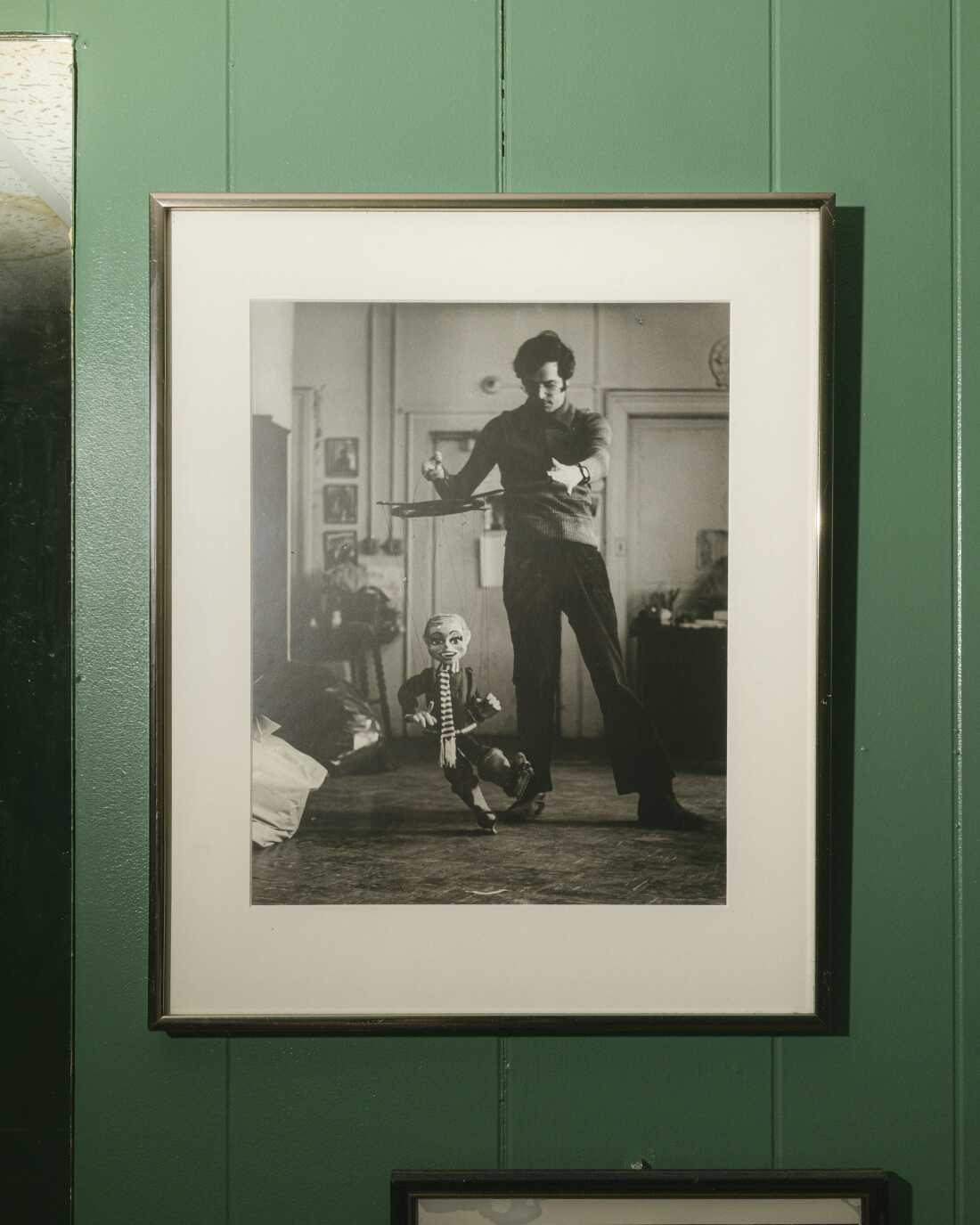
A picture of Nicolas Coppola, Puppetworks’ founder and artistic director, from 1970, in which he’s demonstrating an ice skater marionette puppet.
Anh Nguyen for NPR
hide caption
toggle caption
Anh Nguyen for NPR
For just $11 a seat ($12 for adults), puppets of all types — marionette, swing, hand and rod — take turns transporting patrons back to the ’80s, when most of Puppetworks’ puppets were made and the audio tracks were taped. Century-old stories are brought back to life. Some even with a modern twist.
Since Coppola started the theater, changes have been made to the theater’s repertoire of shows to better meet the cultural moment. The biggest change was the characterization of princesses in the ’60s and ’70s, Coppola says: “Now, we’re a little more enlightened.”

Right: Michael Jones, Puppetworks’ newest puppeteer, poses for a photo with Jack-a-Napes, one of the main characters in The Steadfast Tin Soldier. Left: A demonstration marionette puppet, used for showing children how movement and control works.
Anh Nguyen for NPR
hide caption
toggle caption
Anh Nguyen for NPR

Marionette puppets from previous Puppetworks shows hang on one of the theater’s walls.
Anh Nguyen for NPR
hide caption
toggle caption
Anh Nguyen for NPR

A child attends Puppetworks’ 12:30 p.m. showing on Saturday, Dec. 6, dressed in holiday attire that features the ballerina and tin soldier in The Steadfast Tin Soldier.
Anh Nguyen for NPR
hide caption
toggle caption
Anh Nguyen for NPR
Streaming has also influenced the theater’s selection of shows. Puppetworks recently brought back Rumpelstiltskin after the tale was repopularized following Dreamworks’ release of the Shrek film franchise.
Most of the parents in attendance find out about the theater through word of mouth or school visits, where Puppetworks’ team puts on shows throughout the week. Many say they take an interest in the establishment for its ability to peel their children away from screens.
Whitney Sprayberry was introduced to Puppetworks by her husband, who grew up in the neighborhood. “My husband and I are both artists, so we much prefer live entertainment. We allow screens, but are mindful of what we’re watching and how often.”

Left: Puppetworks’ current manager of stage operations, Jamie Moore, who joined the team in the early 2000s as a puppeteer, holds an otter hand puppet from their holiday show. Right: A Pinocchio mask hangs behind the ticket booth at Puppetworks’ entrance.
Anh Nguyen for NPR
hide caption
toggle caption
Anh Nguyen for NPR
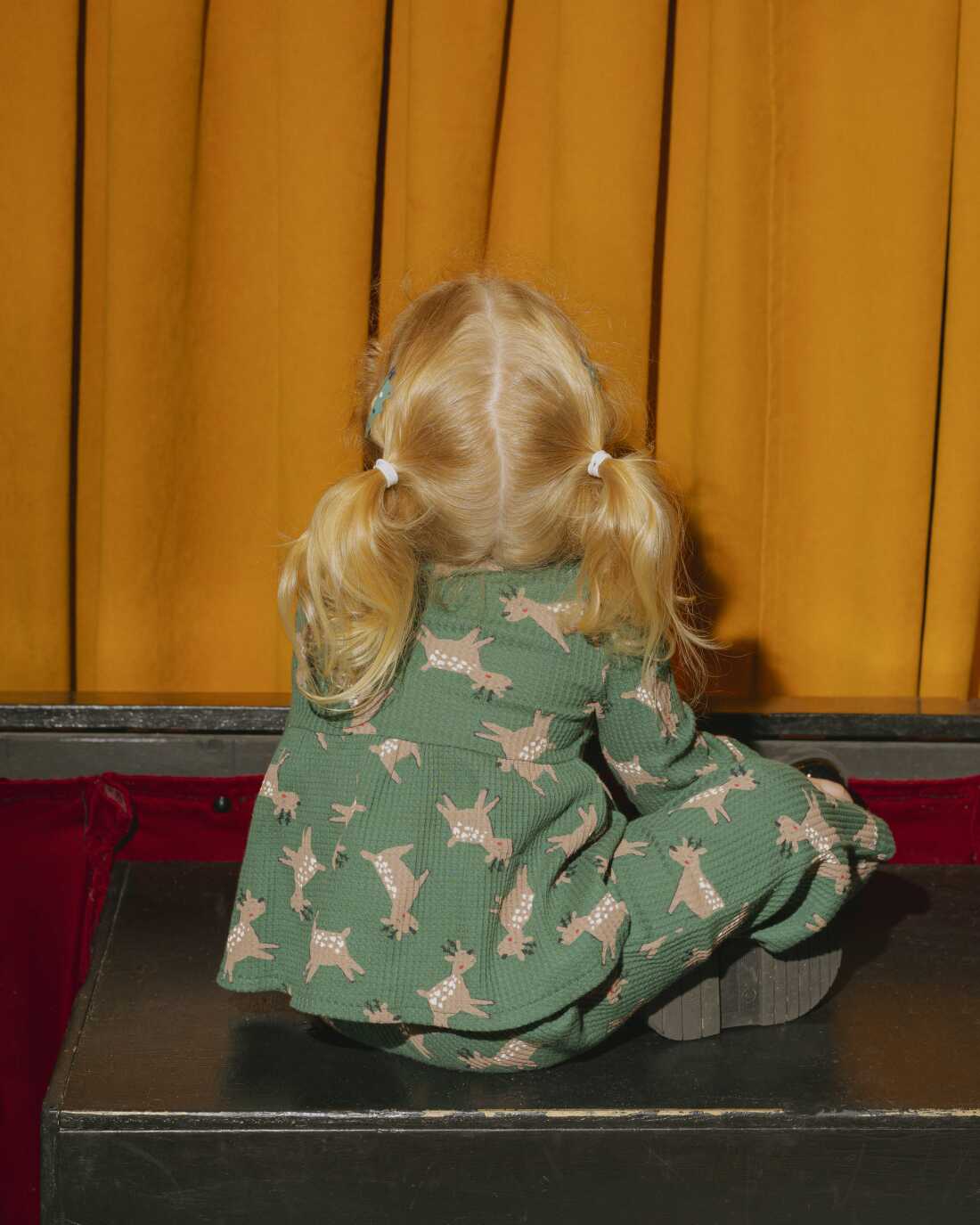
A child attends Puppetworks’ 12:30 p.m. showing on Saturday, Dec. 6, dressed in holiday attire.
Anh Nguyen for NPR
hide caption
toggle caption
Anh Nguyen for NPR

Left: Two gingerbread people, characters in one of Puppetworks’ holiday skits. Right: Ronny Wasserstrom, a swing puppeteer and one of Puppetworks’ first puppeteers, holds a “talking head” puppet he made, wearing matching shirts.
Anh Nguyen for NPR
hide caption
toggle caption
Anh Nguyen for NPR
Other parents in the audience say they found the theater through one of Ronny Wasserstrom’s shows. Wasserstrom, one of Puppetworks’ first puppeteers, regularly performs for free at a nearby park.
Coppola says he isn’t a Luddite — he’s fascinated by animation’s endless possibilities, but cautions of how it could limit a child’s imagination. “The part of theater they’re not getting by being on the phone is the sense of community. In our small way, we’re keeping that going.”
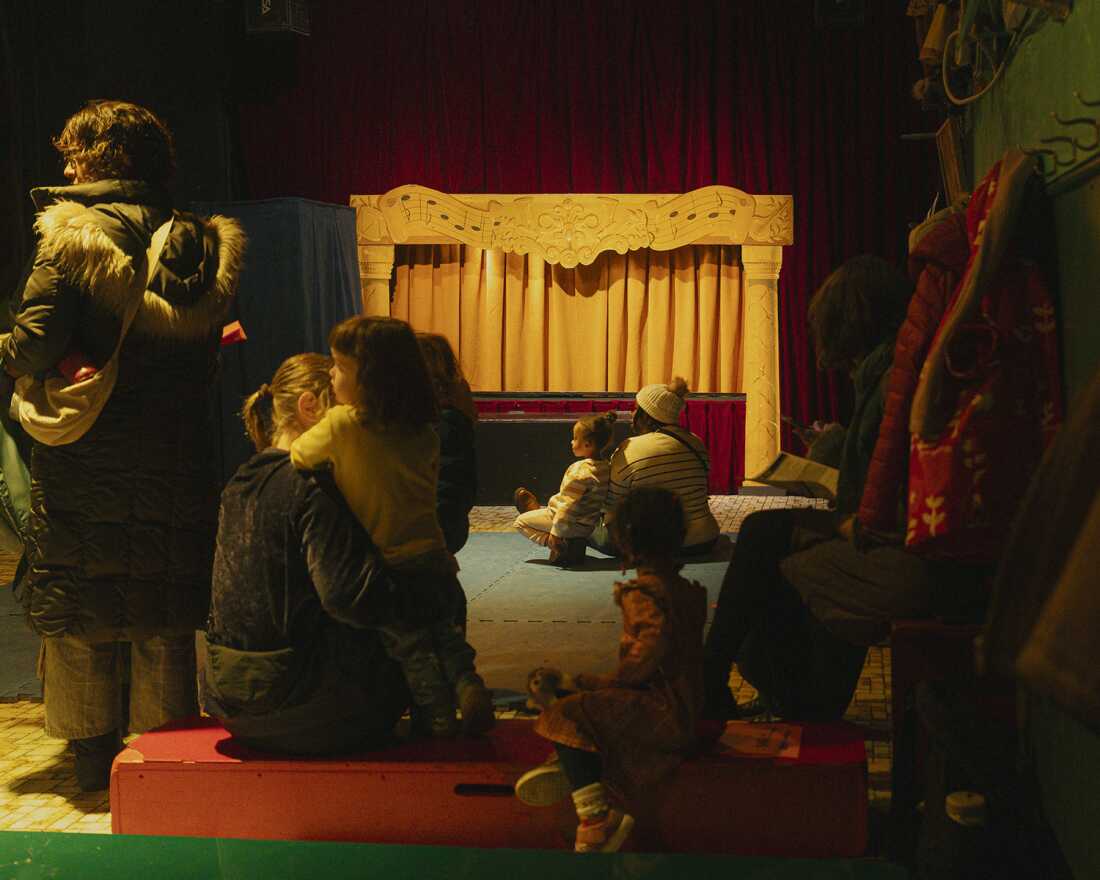
Puppetworks’ 12:30 p.m. showing of The Steadfast Tin Soldier and The Nutcracker Sweets on Saturday, Dec. 6.
Anh Nguyen for NPR
hide caption
toggle caption
Anh Nguyen for NPR
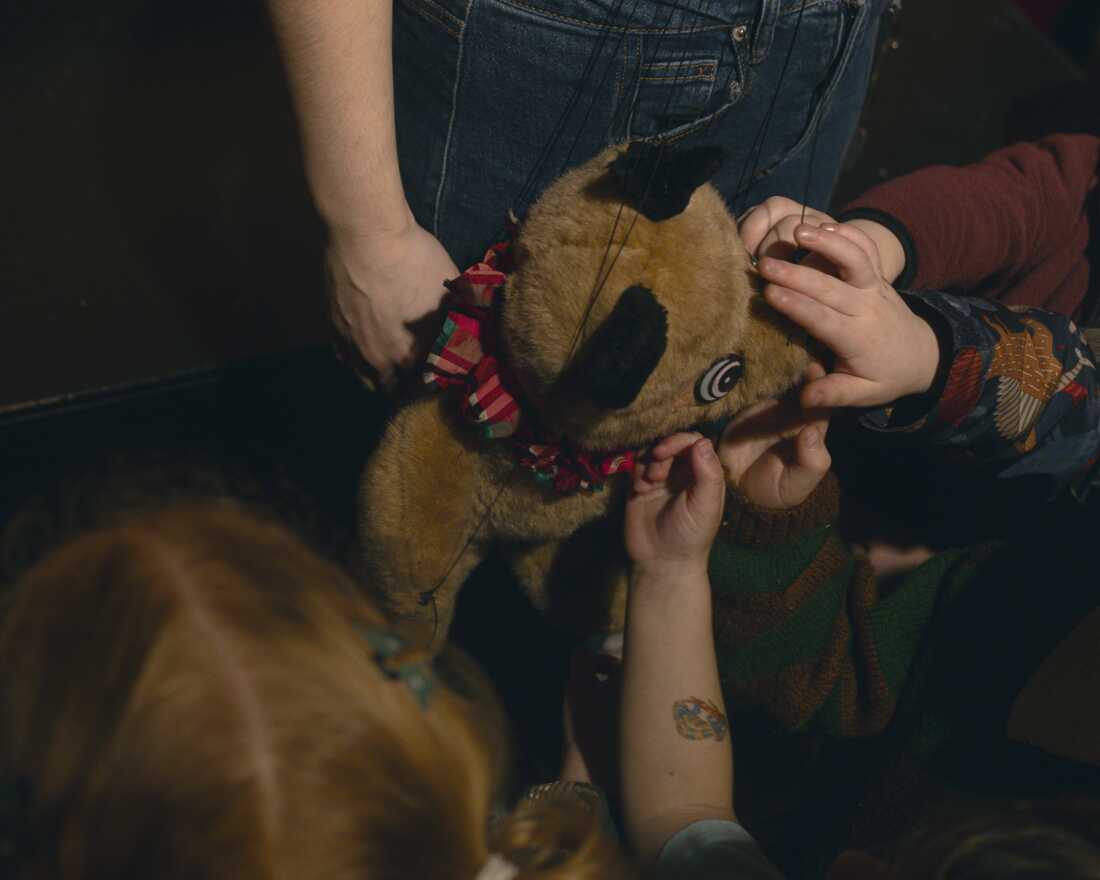
Children get a chance to see one of the puppets in The Steadfast Tin Soldier up close after a show.
Anh Nguyen for NPR
hide caption
toggle caption
Anh Nguyen for NPR
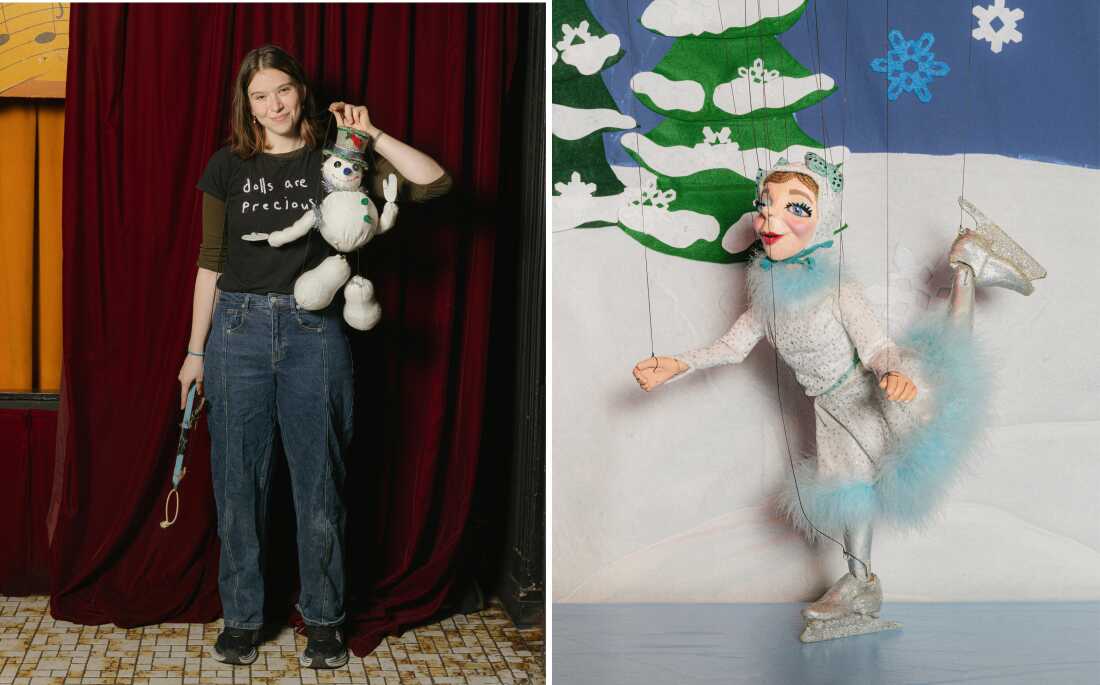
Left: Alyssa Parkhurst, Puppetworks’ youngest puppeteer, holds a snowman marionette puppet, a character in the theater’s holiday show. Right: An ice skater, a dancing character in one of Puppetworks’ holiday skits.
Anh Nguyen for NPR
hide caption
toggle caption
Anh Nguyen for NPR
Community is what keeps Sabrina Chap, the mother of 4-year-old Vida, a regular at Puppetworks. Every couple of weeks, when Puppetworks puts on a new show, she rallies a large group to attend. “It’s a way I connect all the parents in the neighborhood whose kids go to different schools,” she said. “A lot of these kids live within a block of each other.”

Three candy canes — dancing characters in one of Puppetworks’ holiday skits — wait to be repaired after a show.
Anh Nguyen for NPR
hide caption
toggle caption
Anh Nguyen for NPR
Anh Nguyen is a photographer based in Brooklyn, N.Y. You can see more of her work online, at nguyenminhanh.com , or on Instagram, at @minhanhnguyenn. Tiffany Ng is a tech and culture writer. Find more of her work on her website, breakfastatmyhouse.com.
Lifestyle
The Best of BoF 2025: Fashion’s Year of Designer Revamps

Lifestyle
Best Christmas gift I ever received : Pop Culture Happy Hour

-

 Iowa1 week ago
Iowa1 week agoAddy Brown motivated to step up in Audi Crooks’ absence vs. UNI
-

 Maine1 week ago
Maine1 week agoElementary-aged student killed in school bus crash in southern Maine
-

 Maryland1 week ago
Maryland1 week agoFrigid temperatures to start the week in Maryland
-

 New Mexico1 week ago
New Mexico1 week agoFamily clarifies why they believe missing New Mexico man is dead
-

 South Dakota1 week ago
South Dakota1 week agoNature: Snow in South Dakota
-

 Detroit, MI1 week ago
Detroit, MI1 week ago‘Love being a pedo’: Metro Detroit doctor, attorney, therapist accused in web of child porn chats
-

 Health1 week ago
Health1 week ago‘Aggressive’ new flu variant sweeps globe as doctors warn of severe symptoms
-

 Maine1 week ago
Maine1 week agoFamily in Maine host food pantry for deer | Hand Off

























